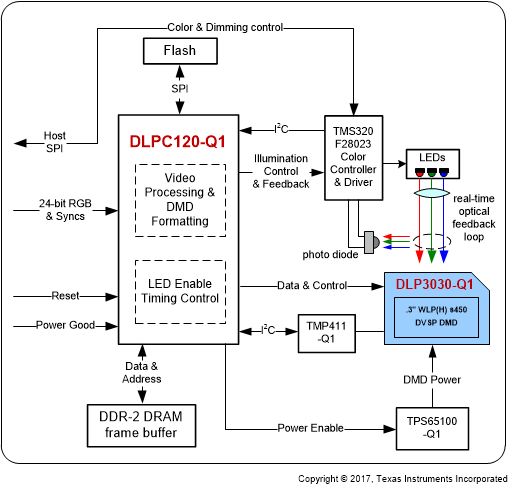ZHCSHX4B November 2017 – June 2019 DLP3030-Q1
PRODUCTION DATA.
- 1 特性
- 2 应用
- 3 说明
- 4 修订历史记录
- 5 Pin Configuration and Functions
-
6 Specifications
- 6.1 Absolute Maximum Ratings
- 6.2 Storage Conditions
- 6.3 ESD Ratings
- 6.4 Recommended Operating Conditions
- 6.5 Thermal Information
- 6.6 Electrical Characteristics
- 6.7 Timing Requirements
- 6.8 Switching Characteristics
- 6.9 System Mounting Interface Loads
- 6.10 Physical Characteristics of the Micromirror Array
- 6.11 Optical Characteristics of the Micromirror Array
- 6.12 Window Characteristics
- 6.13 Chipset Component Usage Specification
- 7 Detailed Description
- 8 Application and Implementation
- 9 Power Supply Recommendations
- 10Layout
- 11器件和文档支持
- 12机械、封装和可订购信息
8.2 Typical Application
The DLP3030-Q1 DMD combined with the DLPC120-Q1 are the primary devices that make up the reference design for a HUD system as shown in the block diagram Figure 17.
 Figure 17. HUD Reference Design Block Diagram
Figure 17. HUD Reference Design Block Diagram The DLPC120-Q1 accepts input video over the parallel RGB data interface up to 8 bits per color from a Video Graphics processor. The DLPC120-Q1 then processes the video data (864 × 480 manhattan orientation) by scaling the image to match the DMD resolution (608 × 684 diamond pixel), applies de-gamma correction, bezel adjustment, and then formats the data into DMD bit plane information and stores the data into the DDR2 DRAM. The DMD bit planes are read from DDR2 DRAM, and are then displayed on the DMD using Pulse Width Modulation (PWM) timing. The DLPC120-Q1 synchronizes the DMD bit plane data with the RGB enable timing for the LED color controller and Driver circuit. Finally, the DMD accepts the bit plane formatted data from the DLPC120-Q1 and displays the data according to the timing controlled by the DLPC120-Q1.
Due to the mechanical nature of the micromirrors, the latency of the DLP3030-Q1 and DLPC120-Q1 chipset is fixed across all temperature and operating conditions. The observed video latency is one frame, or 16.67 ms at an input frame rate of 60 Hz. However, please note that the use of the DLPC120-Q1 bezel adjustment feature, if enabled by the host controller, requires an additional frame of processing.
The DLPC120-Q1 is configured at power up by data stored in the flash file which stores configuration data, DMD and sequence timing information, LED drive information, and other information related to the system functions. See the DLPC120-Q1 Programmer's Guide for information about the this flash configuration data.
The HUD reference design from TI includes the TMS320F28023 Microcontroller (Piccolo) which is used to control the color point by adjusting the RGB flux levels, and drives each RGB LED. This circuit also manages the dimming function for the HUD system. The dimming level of a HUD system requires very large dynamic range of over 5000:1. For example, on a bright day, the HUD system may require a brightness level as high as 15,000 cd/m2 and conversely at night time the minimum brightness level desired may only be 3 cd/m2.